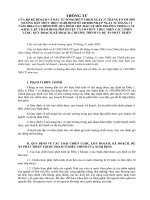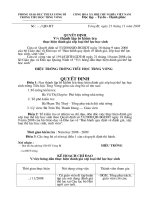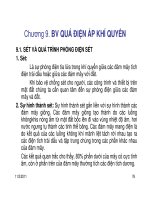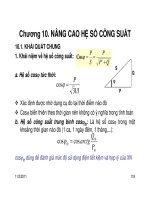Bài giảng Dinh dưỡng cho các lớp Sau đại học 2014 - Bài 6: Lập kế hoạch chương trình đánh giá dinh dưỡng
Bạn đang xem bản rút gọn của tài liệu. Xem và tải ngay bản đầy đủ của tài liệu tại đây (58.26 KB, 25 trang )
Program Planning: Community
Nutrition Assessment
Program Planning Basics
• Systematic process
• Continual feedback and evaluation
• Cyclical: based on increasing
understandings of the true nature of the
situation and the effectiveness of
interventions.
• Starts with an assessment of the current
situation
Process Evaluation
and Adjustment
Assess
Prioritize
Analyze problem and
propose model to address
Develop Intervention
goals, objectives,
implementation plan
Evaluate outcomes
Why Do Assessment?
Community Nutrition Assessment:
• Anchors program/intervention in the reality
of the community
• Essential part of ongoing process:
– Needs assessment
– Designing and implementing services
– Evaluation
– Improving programs and services
• Includes community and stakeholders as
fully active participants
Community Nutrition Assessment:
• Based on assets more than deficits
• Helps to integrate nutrition programs into
community-based health programs and
plans
Successful Community
Assessment Includes:
• Understanding current conditions of
families and individuals
• Evaluating local capacities for supporting
health and nutrition needs
• Building community support for
implementing changes
Models and Protocols for
Community Assessment
• Planned Approaches to Community Health
(PATCH) – CDC
• Assessment Protocol for Excellence in
Public Health (APEXPH) – NACHO (National
Association of County Health Officials)
• Moving to the Future: Developing
Community Based Nutrition Services –
ASTPHND (Association of State and Territorial Public Health
Nutrition Directors)
Strategic Planning for Initiatives to
Address Local Health Efforts
•
•
•
•
Community Assessment
Organize a community planning group
Define community boundaries
Gather information
– Statistical profile
– Qualitative data
– Community Resources
Agency for Health Care Policy and Research
Strategic Planning, cont.
• Analyze Information
– Common issues
– High risk individuals
– Unmet needs
– Prioritize
• Develop and implement community health
plan
• Monitor and evaluate community health
plan
Steps to Assessment
•
•
•
•
•
•
•
•
Convene a planning group
Define community
Identify Community Assets
Identify Perceived Needs
Build Demographic Profile
Analyze Community Health Status
Analyze Community Nutrition Status
Identify Community Resources and Service
Utilization
• Identify common issues and unmet needs
• Prioritize
Community Nutrition Planning
Group: Responsibilities
•
•
•
•
•
•
Collect data and information
Identify health needs and gaps in service
Set priorities
Develop a plan
Help to implement interventions
Assist in evaluation
– Of assessment, planning, and intervention process
– Of impact of intervention
Community Nutrition Planning
Group: Potential Members
•
•
•
•
•
•
•
•
Community leaders
Consumers
Health and Nutrition Service providers
Health organizations
Schools
Political office holders or their staff
Fitness professionals
Representatives from greater community health
planning groups
Define the Parameters
• Public Health Nutrition: Assuring
conditions in which people can be
nutritionally healthy
• Community: “A community is any group
sharing something in common”
Community Tool Box
Community Description
•
•
•
•
•
•
•
•
•
•
•
Geographic boundaries
General history
Key people and leaders
Demographics
Financial & economic information
Important issues
Morale and involvement levels
Key allies and rivals
Unspoken rules and norms
Attitudes and opinions
Strengths and shortcomings
Identify Community Assets
•
•
•
•
•
•
•
Physical structure, place, business
Concerned citizens
History of successful efforts
Organizations
Individual and group skills
Communications systems
Relationships
Identify Perceived Needs
• WHY?
– To understand public opinion
– To become aware of needs the planning
group doesn’t know about
– To gather support & expand group expertise
– To make decisions about priorities
– To plan programs in ways that will be
acceptable to stakeholders
How do we assess perceived
needs?
•
•
•
•
Listening sessions
Public forums
Key informant interviews
Needs assessment survey or survey of
concerns
Demographic Profile
• Economic status: income, employment, %
below poverty
• Education levels
• Age and gender
• Race & ethnicity
• Social factors: homelessness,
immigration status, family composition,
TANF utilization
Community Health Status
•
•
•
•
•
•
Causes of Mortality
Hospital discharge data
Disease prevalence data
Food bourne illness reports
Years of potential life lost
Infant mortality
Community Nutritional Status
• Pregnancy related:
– weight gain in pregnancy
– Pre-pregnancy weight
– Anemia
• Disease prevalence: HIV/AIDS, cardiovascular
disease, diabetes
• Activity levels (BRFSS)
• Food intake: fat, fruits & vegetables (BRFSS)
• Dental health
• Food/dieting related behaviors (YRBS)
• Food Security (BRFSS)
Community Resources & Service
Utilization
• What resources are available?
• To what extent are people using them?
• Sources of Information:
– Citizens
– Service providers
• Tools
– Existing data
– Interviews
– Surveys
Examples of Community Nutrition
Resources
• Food assistance programs (WIC, Basic
Food, etc.)
• Grocery stores with high quality produce
• Food Service with health promoting food
options
• Educational programs
• Media
• Profession and non-profit organizations
• Nutrition counseling
Criteria for defining/prioritizing
community problems
•
•
•
•
•
•
Frequency
Duration
Scope or range
Severity
Perceptions
Root causes (“but why?”) & ability to impact root
causes (effectiveness of interventions)
• Barriers to resolutions
• Political and financial support
Group Work: Develop Problem List
• Brainstorm nutrition related issues &
problems that arise from these data
• Choose 5 issues that are of interest to all
stakeholders
• Prioritize these issues using criteria in
these slides
• Establish the one issue or problem that all
stakeholders will be comfortable working
on for the next two weeks









